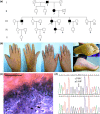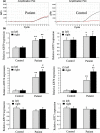Keratin 9 L164P mutation in a Chinese pedigree with epidermolytic palmoplantar keratoderma, cytokeratin analysis, and literature review
- PMID: 31525823
- PMCID: PMC6825865
- DOI: 10.1002/mgg3.977
Keratin 9 L164P mutation in a Chinese pedigree with epidermolytic palmoplantar keratoderma, cytokeratin analysis, and literature review
Abstract
Background: Epidermolytic palmoplantar keratoderma (EPPK) is characterized by hyperkeratotic lesions on palms and soles. The disorder is caused by mutations of keratin 9 (KRT9) or KRT1 gene.
Methods: Epidermolytic palmoplantar keratoderma was diagnosed by physical examination and histopathological analysis in a five-generation Chinese family. Mutation was screened by Sanger sequencing. The palmar expression of multiple cytokeratins were analyzed by tape-stripping and Real-time PCR. Literatures of EPPK with additional symptoms were reviewed.
Results: Affected family members showed diffuse palmoplantar keratosis, with knuckle pads, friction-related lesions and a novel additional symptom of palmar constriction. A heterozygous mutation of c.T491C (p.L164P) of KRT9 was found within the helix initiation motif. The hydrophobic effect was decreased and the initiation of coiled-coil conformation was delayed. The KRT16/KRT6 expression were significantly increased in the patients, especially on the right, indicating activation of stress-response and wound-healing cytokeratins. There were also increased KRT9/KRT2, unchanged KRT10/KRT1, and undetectable KRT14/KRT5 expression. The genetic and phenotypic heterogeneity of EPPK with additional symptoms were summarized by literature review.
Conclusion: The p.L164P mutation of KRT9 caused EPPK with a novel symptom of palmar constriction. The expression of multiple cytokeratins was altered in EPPK patients.
Keywords: EPPK; KRT9; cytokeratin; intermediate filament; mutation.
© 2019 The Authors. Molecular Genetics & Genomic Medicine published by Wiley Periodicals, Inc.
Conflict of interest statement
The authors stated no conflict of interest.
Figures


References
-
- Du, Z.‐F. , Wei, W. , Wang, Y.‐F. , Chen, X.‐L. , Chen, C.‐Y. , Liu, W.‐T. , … Zhang, X.‐N. (2011). A novel mutation within the 2B rod domain of keratin 9 in a Chinese pedigree with epidermolytic palmoplantar keratoderma combined with knuckle pads and camptodactyly. European Journal of Dermatology, 21, 675–679. 10.1684/ejd.2011.1458 - DOI - PubMed
-
- Fu, D. J. , Thomson, C. , Lunny, D. P. , Dopping‐Hepenstal, P. J. , McGrath, J. A. , Smith, F. J. D. , … Leslie Pedrioli, D. M. (2014). Keratin 9 is required for the structural integrity and terminal differentiation of the palmoplantar epidermis. Journal of Investigative Dermatology, 134(3), 754–763. 10.1038/jid.2013.356 - DOI - PMC - PubMed
Publication types
MeSH terms
Substances
LinkOut - more resources
Full Text Sources
Molecular Biology Databases
Research Materials
Miscellaneous

